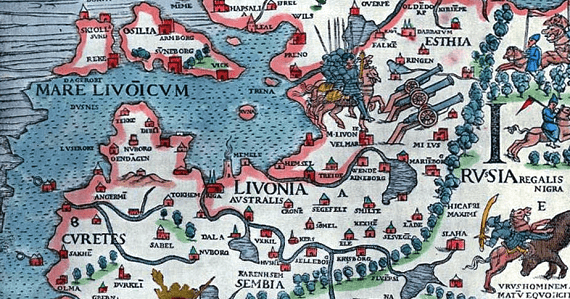St Edmund, king and martyr established an early reputation as a crusaders’ saint. In 1190 Richard I dedicated his crusading fleet to Edmund’s patronage, and in 1211 Richard de Argentyne founded a church dedicated to St Edmund at Damietta in Egypt. While St Edmund never rivalled St George as a crusading saint, he became particularly associated with crusading fleets because he was sometimes invoked as a protector of mariners. The crusades in the Levant were not, however, the only crusades in the medieval world, and throughout the 13th and 14th centuries nobles from throughout Christendom undertook a reyse (seasonal campaign) with the Teutonic Knights, the crusading order based in Prussia and Livonia (modern Latvia and Estonia). The aim of the Teutonic Knights was to conquer and convert the pagan Lithuanians who continued to resist Christendom, and whose tactics of guerrilla warfare made it impossible for the Knights to establish an occupation.
The dwindling of Levantine crusading opportunities in the late Middle Ages meant that reysen to the Baltic became increasingly popular with English and Scottish nobles who were keen to gain military experience. From the 1350s onwards it became fashionable for the wealthiest magnates to kit out crusading fleets and travel to Königsberg, the Prussian capital, before proceeding into the heathenesse of Lithuania. There has hitherto been no indication that the cult of St Edmund was in any way involved in the Baltic crusades, but there is one hint that a northern crusader did have St Edmund in mind as a patron.
While the best known of these reysen is that undertaken by Henry, earl of Derby (the future Henry IV) in 1390, the largest English reyse was in fact equipped by Thomas Woodstock, duke of Gloucester in 1391. By this time Lithuania was in fact a Christian country, but still at war with the Teutonic Knights, who made use of crusading as a spurious excuse to attract foreign support for their cause. There is no direct evidence that Gloucester’s crusade was placed under the patronage of St Edmund, but it is suggestive that the bishop of Winchester, William Wykeham, issued prayers in support of Gloucester from Esher on 20 November 1391 – St Edmund’s Day:
Almighty and merciful God, Lord of lords, who teaches the hands of the just for battle and their fingers for war, be pleased to accept the prayers of your devoted people; let him subject those he wishes to subject, and with those whom he wishes, give him victory.
Since, therefore, the renowned and illustrious prince, the Lord Thomas, duke of Gloucester, placing his hope in the Lord, is about to go on pilgrimage to foreign and distant parts to fight the enemies of the Cross of Christ, on account of devotion, we attentively beseech your devotion (and all the saints of God be had in devotion), since he has now absorbed heavy labours and expenses in his journey, that you have the aforesaid Lord Thomas, duke of Gloucester, in your masses and other prayers (exhorting you likewise in the Lord) as a pious proposal.
The bishop went on to offer an indulgence of 40 days to those who prayed for the duke. By the time the prayers and indulgence had been issued the duke had already departed (at the end of October), and as it happened he never reached his destination, being tossed about by storms on the North Sea for six weeks until landing in the north of Scotland. However, although St Edmund is not mentioned in Bishop Wykeham’s prayers, the date of the prayers’ issue may be an indication that Gloucester dedicated his crusading fleet to St Edmund. Wykeham did not issue the prayers to coincide with Gloucester’s departure, and unless the month it took the prayers to be issued was merely an administrative delay, the day chosen for their promulgation was surely significant. By 1391 St Edmund’s Day was one of the most significant in the calendar of the English church, and a holy day of obligation when everyone was required to attend mass. Furthermore, most of Gloucester’s followers came from East Anglia and the fleet departed from the Suffolk coast, making a dedication to the East Anglian saint most fitting.
So it seems that St Edmund never got the chance to be a patron of crusaders in the Baltic, although Thomas of Woodstock may well have wanted him to be…
